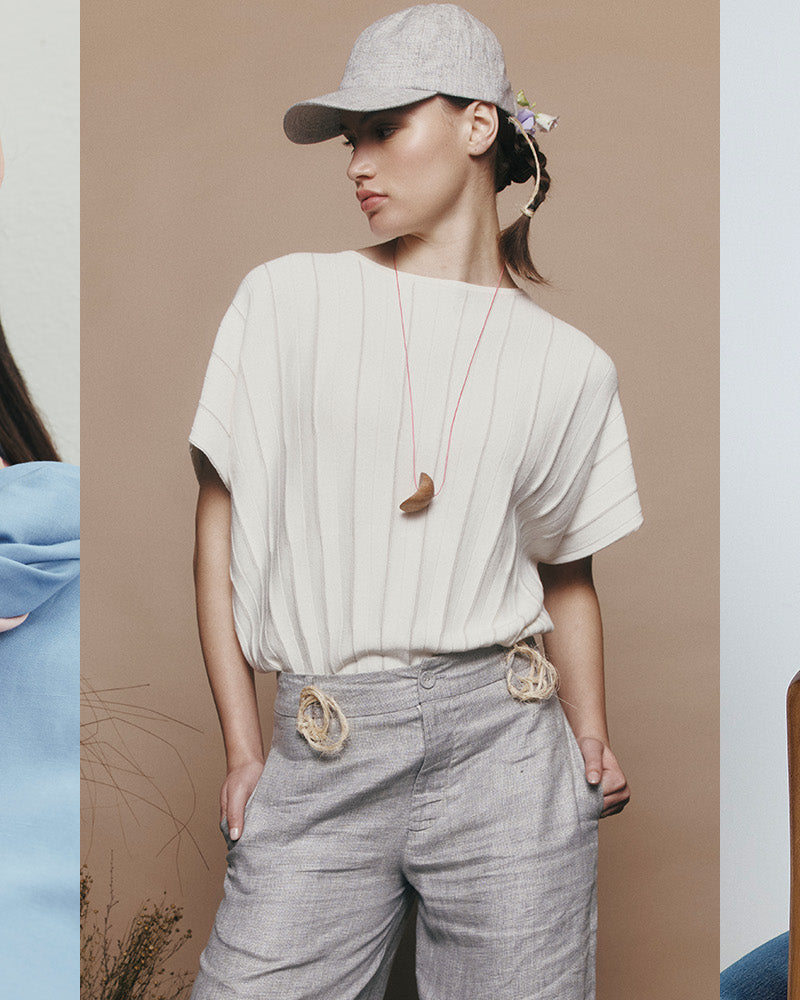We all know that well-made, good-quality knitwear is an investment item, and as with any investment, it’s best to approach any decision with as much knowledge as possible. Don’t know a saddle shoulder from a snood? Read on as we explain key terminology, common styles and the efficacy of different fibres.
Cardigans, crewnecks, cables and all the terminology you need.
Boatneck
A very elegant style of neckline, boatnecks are cut wide and straight across the collarbone. Their name is indicative of their history, with the distinctive cut being utilised for sailor’s uniforms due to its ability to be pulled on and off quickly (helpful in the off chance someone ended up overboard). They’ve since become a classic element for knitwear, popular in the 1950s and again in the 1980s.
Cable knit
An evocative category of knitwear that’s instantly recognisable thanks to its distinctive patterns of intertwining ribs – some of which are notably ornate – cable knit is however, traditionally, a practical style. Associated with fishing and cricket, it originated in the Aran Islands, where it kept the wearer warm in rugged conditions. Contemporarily, you’ll find cable-like designs of all scales on everything from chunky sweaters to delicate cardigans, and we use the design across our men's and women's knitwear.

Crew Neck
The most common neckline we make, this classic cut can be found on everything from sweaters and cardigans to vests and knitted T-shirts. A crew neck is round and cut high on the collarbones, sitting snug around the neck. Universally flattering, versatile and practical - its close cut helps keep out the chill – it makes for a foundational wardrobe item. Like so much knitwear terminology, the name has its origins in sport and seafaring, appearing on T-shirts (sweat-absorbing undergarments also used as an athletic layer) and knitwear. The name is commonly attributed to athletes who “rowed crew”, though some sources also credit it to their role in naval uniforms.
Dolman sleeves
Also known as a batwing sleeve, this style is wide at the top and narrow at the wrist. Sometimes it’s a separate piece, attached at the shoulder, other times it’s formed by extending the body of the garment to the sleeve. Either way, the effect is luxurious, particularly when it comes to knitwear, as the volume of the cut looks particularly stylish when executed in a fine wool, thanks to the softness and drape.
Funnel Neck
As far as extended collars go, a funnel can be less constricting if that’s your taste. Less fitted than a turtleneck, though with a similar look – covering and elongating the neck – a funnel extends up from the body of a jumper without folding over and can be loose or fitted. As with its cousins the turtle and mock neck, the benefits are practical as much as aesthetic; and the extended neckline keeps you warm as temperatures drop.

Half Zip
A familiar sight these days, this classic knit goes well with a collared shirt and under a jacket, recent years have seen them become a modern staple for menswear. In fact, they’ve come to form part of the contemporary corporate uniform – as well as smart, off-duty outfits – and are increasingly favoured by famous public figures, including Barack Obama, who has worn Untouched World’s Estuary Half-Zip. The zip-placket collar does double service, pairing well with a collared shirt underneath, or being zipped up to protect a bare neck from the elements.
Moss stitch
This is an easily identified knitting pattern, once you know what to look for – a unique, grid-like texture – moss stitch is formed by alternating knit and purl stitches with each row. Beyond the surface appeal, it also serves to insulate the wearer thanks to its dense knit. The name has a poetic lineage, said to reference the carrageen moss of coastal Ireland.
Polo
Not to be confused with a polo neck, a polo shirt features a shirt-style collar and demi placket, usually with buttons. As its name suggests, its origins lie in sports, and the style has a long history in preppy fashion. When knitted from a fine-gauge yarn, long-sleeved polo shirts look smart and elegant, and they’ve become an acceptable alternative to cotton business shirts for officewear – also proving a popular choice on weekends, making them especially versatile.

Raglan sleeve
Another design element with a functional original, This style of knit sees the sleeve top extended across the shoulder and into the neckline, rather than stopping at the armhole, and common on outerwear, sweatshirts and knitwear. Though the famous story goes that it was designed by FitzRoy Somerset, Baron Raglan to allow for a better range of movement after he lost a hand in combat, the cut is, in fact, ancient; garments with raglan-style sleeves have been dated as far back as the Ancient Greece. And no wonder, it’s comfortable for a range of body types and highly practical.
Ribbed
A style of knitting, the most famous iteration is the traditional fisherman rib knit; designed for necessity, its thick yarn, dense knit and ribbed design insulated the wearer from the elements. Many modern knits pay homage to this history, while others go an altogether different route; utilising narrow ribbing and fine-gauge yarn, the vertical line of ribbing creates visual interest, while form-fitting cuts can have a figure-hugging quality.

Round neck
Similar to a crew neck in shape but cut slightly less close to the neck, this style is simple and stable – never really falling in nor out of fashion. In fact, it’s quite ancient, due to its simplicity and ease, and some historians date it to Mesopotamia. The term “round neck” is thought to have been first documented in the mid-1700s, though such an obvious descriptive term was likely used well before that.
Saddle shoulder
The sibling to the raglan, this sleeve cut looks like you’d imagine. It’s joined to the neckline via a narrow band of fabric extending at the top of the sleeve head. Popularised in the 1920s, it works well on knitwear, adding shape and fitting, and done well can enhance the shape of a wearer’s shoulder.

Snood
Traditionally worn for outdoor pursuits, this snug, cylindrical accessory goes around the neck for added warmth. When worn with a matching sweater, the effect is that of a turtleneck or funnel neck, and the freedom to remove the snood when the temperature rises makes it a versatile and adaptable piece of knitwear.
Tipping
As its name suggests, this term - sometimes written as “tipped” – describes a thin, decorative band of contrasting colour or tone at the edge of a sweater’s cuff and hem, and it’s a quiet way to add some interest to what’s otherwise a simple sweater.

Turtleneck
A codeswitching classic, this timeless category of knitwear has historic associations with both status quo and counterculture. A traditional turtleneck (sometimes known as a roll neck or polo neck) has a tubular, close-fitting collar, and differs from its cousin, the mock neck, due to its rollover, which can however also be worn unfolded for aesthetics or warmth.
V-neck
Very famous, very versatile, and all about the V, these can be cut close to the neck or end lower down on the chest. Often intentionally revealing what’s underneath, they’re well-suited to a collared shirt and tie or, in the case of a deep V, can show some décolletage if so desired.















